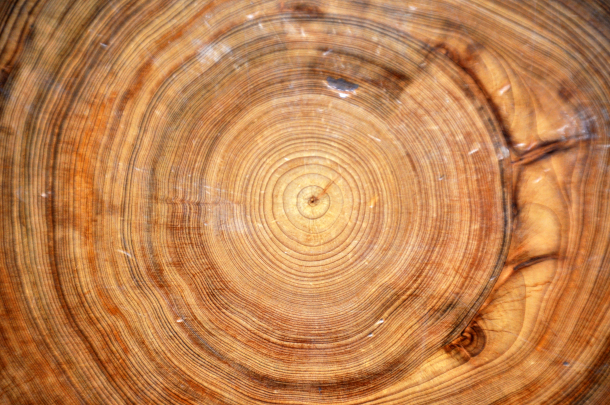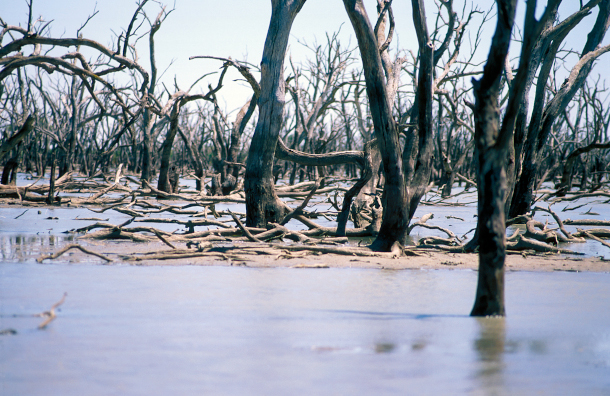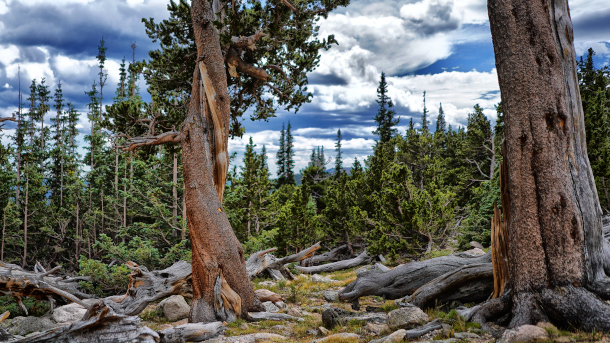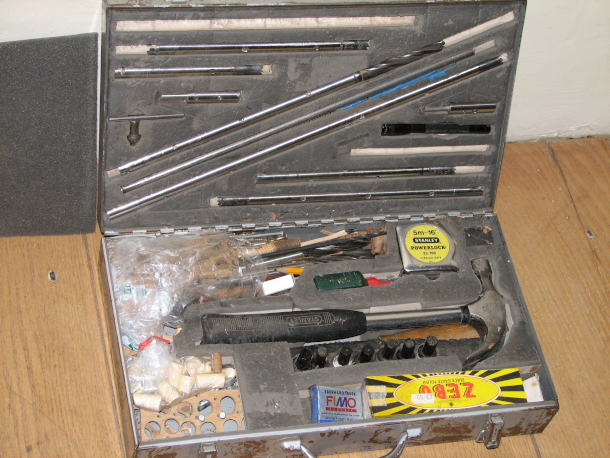Tree Story: The History of the World Written in Rings
Air Date: Week of November 13, 2020

Each tree ring represents a year in the life of the tree. The youngest rings are the outer ones, closest to the bark. This bald cypress is estimated to have been about 700 years old when it was fossilized. (Photo: James St. John, North Carolina Museum of Natural Sciences, Flickr, CC BY 2.0)
Trees are constantly storing information about climatic conditions in the rings they lay down each year. Paleoclimatologist Valerie Trouet of the University of Arizona uses the science of dendrochronology to learn about the ancient climate on Earth by studying tree rings. She’s the author of “Tree Story: The History of the World Written in Rings,” and joined Host Bobby Bascomb to talk about the incredible discoveries scientists have made thanks to tree rings.
Transcript
CURWOOD: It’s Living on Earth, I’m Steve Curwood.
BASCOMB: And I’m Bobby Bascomb.
As we enter uncharted territory for humans with climate change many scientists are turning to the past to find answers about what to expect in the future. Shifts in the global climate happen naturally over millennia and they can leave a number of clues behind. At the University of Arizona, paleoclimatologist Valerie Trouet uses dendrochronology to learn about the ancient climate on earth by studying tree rings. Trees are constantly storing information about climatic conditions and some of them can live to be thousands of years old. Professor Trouet’s book, “Tree Story,” is about the science of tree rings and she joins me. Valerie, welcome to Living on Earth!
TROUET: Thank you so much for having me, Bobby.
BASCOMB: So, Valerie, how do you use tree rings to uncover information?
TROUET: What we do is we measure the width of those rings. And that gives us a lot of information about the past. So, for instance, I'm primarily interested in using tree rings to study the climate of the past. And the way that works is that if it's a good year, and the tree is happy, it will grow a lot and grow a wide ring. On the other hand, if it's a very dry year in Arizona, and the trees will be unhappy and form a very narrow ring in that year. And so if you have a 500 year old tree from Arizona, by measuring how wide or narrow each of those 500 rings in the tree is, that'll give you an idea of which ones were the wet years, represented by the wide rings and which ones were the dry years represented by the narrow rings in the past.
BASCOMB: And is it only precipitation that you can uncover by looking at these tree rings? What other information is available to you?
TROUET: Yeah, so that's a really good question. So I give the example of trees in Arizona where it's dry. But it's a very different story, for instance, in the European Alps, or in Canada, or Alaska, where it never really gets too dry for trees to grow a lot or to be happy, but it can get too cold. So the trees there record temperature, how hot or how cool it is, rather than how dry or how wet it is. Now the other thing is that we're not limited to living trees alone, we can really study the rings, and pretty much anything that's made out of wood, as long as it has enough rings in it. And so through the process of matching the patterns in the ring that I was talking about earlier, the patterns in the tree rings, we can also date wood that we don't necessarily know when it was used. But by matching it to the patterns of living trees, we can date when, for instance, archeological sites were built or when historical buildings were built, or when paintings were painted, or when musical instruments were made. So we can date a lot of wood material very precisely to the exact year by using dendrochronology.
BASCOMB: So, the idea there is if you have enough trees that overlap in years that they were living, you can actually look back quite far in time. And from what I understand, you can even use charcoal, you know, pieces of trees, as is the case from the Four Corners region. Is that right?
TROUET: Yeah, that's right. And I think that's really amazing as long, again, as long as they have enough rings in them, those pieces of charcoal. So, the structure of the wood is preserved in the charcoal, so you can still see the rings in the charcoal.

Dead trees in the Barrenbox Swamp Near Griffith, New South Wales, Australia. (Photo: Gregory Heath, CSIRO Science Image, CC BY 3.0)
BASCOMB: And then, you know, physically how do you get a core from a tree? And does it hurt the tree?
TROUET: Yeah, good question. Actually, I should have mentioned this much earlier that, to sample trees as dendrochronologists we don't cut down trees, it's very important to know that when we take a sample of it with a hollow core, so we have a core, it's about a quarter of an inch in diameter that we core by hand into the tree. And that allows us to extract a sample. It's a bit like a biopsy or drawing blood from a tree. And a sample you can think of it as like it's about the length and the diameter of a pencil. So you extract a pencil out of the tree that shows all the tree rings on it. And it doesn't hurt a tree because we have to think of a tree, at least a stem of a tree. You know, 99% of the stem of a tree is dead already. The only living part of the stem of a tree is a very thin layer of cells, we call the cambium cells in between the bark and the wood. So everything that's wood is dead already. And so when we sample the tree with our core, you only take a sample of about a quarter of a diameter out of the living tissue, out of the cambium, everything else is dead already so it doesn't harm the tree at all.
BASCOMB: Now, you say that most times you just take this sample and it doesn't hurt the tree, but I actually took a dendroclimatology class in graduate school and heard this story that I kind of thought was a bit of urban legend, but you confirm it in your book, of a researcher who got his instrument stuck inside of a tree so he applied to get a permit to cut it down. What happened? Can you tell us that story?
TROUET: Yeah, that's a very unfortunate story of Don Currey, who was a graduate student in the 60s, in the early 60s, who was interested in studying the Bristlecone pines that grow on the border between California and Nevada in the White Mountains. He was interested in studying them to look at past glacier activity in that region. It's not entirely clear why he switched from a bore to cutting the tree, but he started off with a bore, but for some reason...I mean, these are... these bristlecone pines are very gnarly and complex trees. They're not easy to core. But for some reason, he decided I'm not going to core his tree, he applied for a permit from the Forest Service to cut it down. He got the permit, cut it down with a chainsaw, and then brought the cookie sort of, a disk from one particular tree that he had in mind, brought the cookie back to his hotel room at night, and then started counting the rings in the sample from the tree that he had just killed. And it turns out that he had just killed the oldest living tree on Earth at that point in time, that we were aware of. So he killed the bristlecone pine, he cut it down, that was almost 5000 years old. Luckily, in 2012, one of my colleagues at the University of Arizona in the tree ring lab found another bristlecone pine that was even older than the one that had been killed. So the one that had been killed was not the oldest living tree on Earth. The now oldest living tree on earth is more than 5000 years old, it was 5062 years old when it was sampled in 2012. And its location and its identity are kept a secret, so that no one will hurt it.
BASCOMB: And you were also a part of a team that sampled trees from historic buildings in ancient Rome. What did you uncover with that work?
TROUET: It's interesting, because from Roman times in Europe, the aboveground wood is no longer around. That's been the case for a very long time now. But what is left in terms of Roman wood is wood that they use to build and align their water wells, because that wood was underwater for most of history. And so when it's underwater, it's preserved in anoxic conditions, in conditions without oxygen. And so bacteria cannot get to it. So we dated a lot of that archaeological wood from Roman times. And then we used it, combined with wood from living trees and from historical buildings, to develop a climate reconstruction for Europe going back 2500 years. And what we then found is that during Roman times, that this was a period of a very fluctuating climate, so of severe changes in climate. It would be wet for a couple of decades, and then dry again for a couple of decades, wet again for a couple of decades. So, we then hypothesized that this climate variability, these extremes in the climate might have contributed to the fall of Rome, or the disintegration of the Western Roman Empire.

These bristlecone pines in Clear Creek, Colorado, are estimated to both be over 1,000 years old. (Photo: Barry Dale Gilfry, Flickr, CC BY-SA 2.0)
BASCOMB: Wow, it's so interesting, what you can infer from these tree rings. You also talk in your book about Genghis Khan, and the tree rings that were dated from that time. Can you tell us about that?
TROUET: Yeah, that's one of my favorite stories. That's work by my colleague, Amy Hessl from University of West Virginia and Neil Pederson from from Harvard forest. They went to Mongolia, sampled some extremely old trees there, and then also used them to reconstruct the climate of the past. Now in Mongolia, what they were able to reconstruct is drought and wet periods in the past. And so when you think of Mongolia, when you look at the history of Mongolia, the period when Genghis Khan came to power is a very interesting period in Mongolian history. So when they looked at their climate reconstruction, their drought reconstruction, for the period, I want to say in the early 13th century, they noticed that this period that Genghis Khan was able to build his empire and expand his empire was actually one of the wettest periods in Mongolian history. It's almost an opposite of the story of the Roman Empire, where climate helps to explain, or is one of the factors contributing to the fall of Rome. In Genghis Khan's case, it's the other way around, where the really good climatic conditions, climate conditions, help him to build this and expand his empire.
BASCOMB: Well, this is just so fascinating, but what for you, what are some of the biggest discoveries of dendrochronology thus far?
TROUET: So these kind of collaborative research projects is what I find very exciting. A beautiful example is that of colleagues of mine who studied the ghost forests in the pacific northwest of the United States. So, ghost forests are forests of standing trees, standing dead trees. So, these are trees that died a few hundred years ago, but are still standing. And some of my colleagues sampled them, tree ring dated them, in four of those ghosts, forests and discovered that they all died in the exact same year, sometime in the winter between 1699 and 1700. And so, their hypothesis was that there was an earthquake in that year, that caused the ground to sink and salt water to come in, and so kill all of those trees at once. But when it came really interesting is when simultaneously in Japan, so on the other side of the Pacific, there were environmental historians who studied the history of tsunamis in Japan. And so they had found through going through written documents in Japan, that in the winter of 1699, to 1700, actually, on January 26, of the year 1700, there'd been a tsunami in Japan that had flooded pretty much the entire coast of Japan. So, there were records of shipwrecks, records of agricultural lands that had been flooded, and so forth. But there was no record of anything that might have caused that tsunami. So they called it the orphan tsunami, because they knew there was a tsunami, but they didn't know where it was coming from. And it wasn't until those environmental historians from Japan started talking to the dendrochronologists in the Pacific Northwest, on the other side of the Pacific, that they put one and one together and realized that it was a massive earthquake in the Pacific Northwest that caused the trees there to die. But that also went all the way across to Japan, and then caused a tsunami on that side of the Pacific. And so I think that's a really beautiful story to demonstrate what all we can find out with tree rings, and by collaborating with other scientists. But also it's a warning, because until that study, they didn't realize that earthquakes of that magnitude could occur in the Pacific Northwest. I mean, yeah, it must have been an earthquake of magnitude 8 or 9 to reach all the way to Japan. So, it's a warning for the possibility of environmental conditions that are possible.

A toolbox full of instruments used for dendrochronology at the Metropolitan Museum of Art. (Photo: The Metropolitan Museum of Art. Flickr, CC BY-NC-ND 2.0)
BASCOMB: Well, looking down the road a bit, what excites you most about possible applications for dendrochronology?
TROUET: One, I think, benchmark study, that was published about 20 years ago in 1998, and we keep seeing the same thing ever since, is the extraordinary character of the current climate change, and specifically how the current warming, global warming, is compared to the past. So, you know, we've been measuring the climate temperatures and precipitation with instruments, you know, let's say, since the early 1900s, on a global scale. The problem is that that's also the period after the start of the Industrial Revolution, since we've also been really messing with the climate. So by looking at instrumental data alone, we don't really have a good record of what natural climate variability is like, we only have a record of what the climate is like when we are influencing it as humans. So, to go further back in time to look at natural climate variability, that's where tree rings come in. So, they allow us to put the current climate change in a much longer-term context. And for instance, that hockey stick study shows that the current warming since the 1900s is really unprecedented over the last 1000 years. And it's called a hockey stick, because it describes the curve of the global temperatures over the past 1000 years. And so it slowly cools since 1000, to about 1850, and then there's a really steep increase in temperature since then. This steep increase, you keep seeing in the tree rings. Wherever, wherever I go, where the trees are sensitive to temperature, you always see an unprecedented warming in the 20th century, it's everywhere. You know, dendrochronology, really, we're able to study forests of the past, we're able to study climate of the past, we're able to study archaeology and human history. And so the link between those three, it's really, it's dendrochronology. It sits at the nexus between ecology, climatology, and archaeology. And so, as we move forward in a warming world where, you know, climate is gonna have a very big impact on ecology and ecosystems, it's also gonna have a big impact on humans, being able to provide a longer term and historical context to what we're seeing here. What is happening here and now, I think is exciting.
BASCOMB: Valerie Trouet is a paleoclimatologist at the University of Arizona and author of Tree Story. Valerie, thank you so much for sharing all of these tree stories with us.
TROUET: Thank you so much for having me, Bobby.
Links
Living on Earth wants to hear from you!
Living on Earth
62 Calef Highway, Suite 212
Lee, NH 03861
Telephone: 617-287-4121
E-mail: comments@loe.org
Newsletter [Click here]
Donate to Living on Earth!
Living on Earth is an independent media program and relies entirely on contributions from listeners and institutions supporting public service. Please donate now to preserve an independent environmental voice.
NewsletterLiving on Earth offers a weekly delivery of the show's rundown to your mailbox. Sign up for our newsletter today!
 Sailors For The Sea: Be the change you want to sea.
Sailors For The Sea: Be the change you want to sea.
 The Grantham Foundation for the Protection of the Environment: Committed to protecting and improving the health of the global environment.
The Grantham Foundation for the Protection of the Environment: Committed to protecting and improving the health of the global environment.
 Contribute to Living on Earth and receive, as our gift to you, an archival print of one of Mark Seth Lender's extraordinary wildlife photographs. Follow the link to see Mark's current collection of photographs.
Contribute to Living on Earth and receive, as our gift to you, an archival print of one of Mark Seth Lender's extraordinary wildlife photographs. Follow the link to see Mark's current collection of photographs.
 Buy a signed copy of Mark Seth Lender's book Smeagull the Seagull & support Living on Earth
Buy a signed copy of Mark Seth Lender's book Smeagull the Seagull & support Living on Earth

